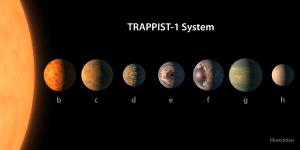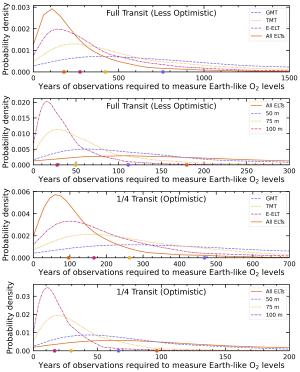Blog
The Oxygen Observation
2 May 2023
 NASA/R. Hurt/T. Pyle
NASA/R. Hurt/T. PyleIf we ever find life on other worlds, it is unlikely to be a powerful message from space. It’s certainly possible that an alien civilization specifically sends us a radio message like a scene out of Contact, but the more likely scenario is that we observe some kind of biological signature in an exoplanet’s atmosphere, such as oxygen or chlorophyll. But as a recent study shows, that could be more difficult than we thought.1
There is reason to be hopeful. We are already able to image some exoplanets directly and have detected molecules such as water in their atmospheres. The planets we’ve directly observed are all gas giants, though. We can’t image Earth-sized planets in a star’s habitable zone yet, but there is a trick we can use to study their atmospheres.
Most of the planets we’ve discovered are found by the transit method, where the planet passes in front of a star causing the star’s observed brightness to dip slightly. But while the planet is in front of the star, some of the starlight will pass through the planet’s atmosphere before reaching us. By observing the star’s spectrum during a planetary transit we can measure what light the atmosphere absorbs. From the absorption lines, we can determine the composition of the planet’s atmosphere.
 NASA/Kepler/K2
NASA/Kepler/K2It’s a small effect, but is it big enough to be useful to astronomers? That’s the question this new study wanted to answer. For current observatories, the answer is clearly no. So the team focused on simulations of telescopes that will go live in the relatively near future. These Extremely Large Telescopes will have mirrors of 10 meters or more, perhaps as large as 50-100 meters. And while these telescopes should be able to detect all kinds of molecules in a planet’s atmosphere, the team focused on oxygen. Oxygen is unstable in an atmosphere because it reacts so strongly with other materials. On Earth atmospheric oxygen is replenished by living things. If we detect oxygen in an exoplanet’s atmosphere, that’s a good indicator that life could be there.
The good news is that these future large telescopes would be able to observe oxygen in an exoplanetary atmosphere. The atmosphere would need to be reasonably transparent and thick, but it’s possible. The bad news is that astronomers will have a dickens of a time filtering out the signal from the noise. Even these large telescopes will capture only a few pixels of light from a star, and atmospheric observations can only happen while the planet is transiting. This means that to find the signal within the noise, astronomers will have to observe multiple transits. Possibly hundreds of them.
 Hardegree-Ullman, et al
Hardegree-Ullman, et alAs an example, the team looked at a planetary system known as Trappist-1. It’s about 40 light-years away and has 7 planets that are roughly Earth-sized. Four of them orbit within the star’s habitable zone. Since Trappist-1 is a red dwarf star, the habitable zone is quite close to the star, and the potentially habitable worlds have orbital periods of between 4 and 12 days. If we assume these planets have atmospheres similar to Earth’s, with plenty of free oxygen, it would take thousands of transits to get a positive result. The team looked at a 3σ threshold of certainty and found it would take between 16 to 55 years of observations to confirm atmospheric oxygen, and that’s using telescopes that still haven’t been built.
The good news is that, in time, we should be able to discover life on other worlds. The bad news is we’re going to have to be very patient.
Hardegree-Ullman, Kevin K., et al. “Bioverse: A Comprehensive Assessment of the Capabilities of Extremely Large Telescopes to Probe Earth-like O2 Levels in Nearby Transiting Habitable Zone Exoplanets.” arXiv preprint arXiv:2304.12490 (2023). ↩︎